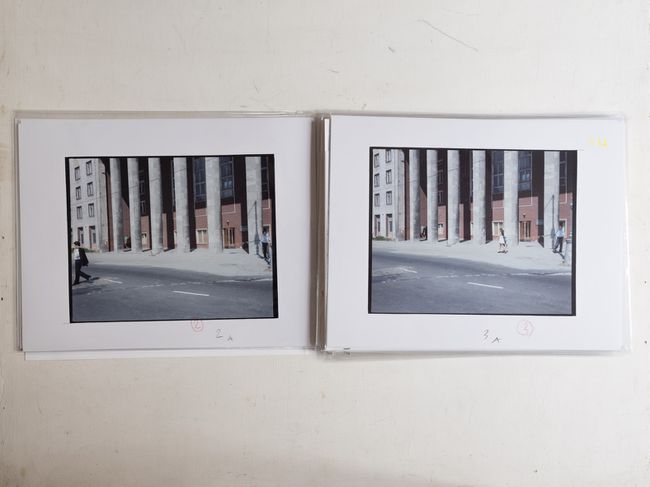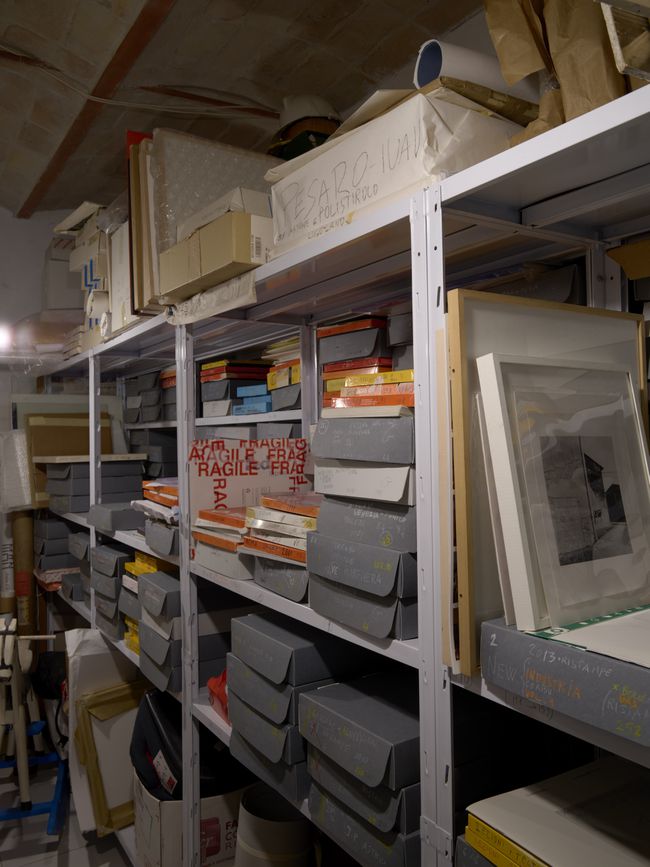Photographic Pilgrimage
Guido Guidi in conversation with Stefano Graziani and Bas Princen
This oral history was filmed by Jonas Spriestersbach in July 2022 at Guido Guidi’s studio in Cesena. It is part of the CCA project The Lives of Documents—Photography as Project, an open reflection on how past and contemporary image-making practices serve as critical tools to read our built environment and design today’s world.





- SG
- How did you come up with the idea for the photographic itinerary you took in your book In Between Cities: An Itinerary Through Europe 1993/1996?
- GG
- I was at the Ca’ Tron building at the Istituto Universitario di Architettura in Venice in 1993. I remember I went to the café there and ran into Marco Venturi. Ciao Marco, I said, and asked him, since you have access to the university’s research funds, why don’t we organize a trip across Italy, as Elio Vittorini had done in his time? He looked at me for a moment and responded that we could instead organize a trip across Europe because he had access to ministerial research funds.
We initially took fifteen days to complete the first legs of the trip during our August vacations. We went directly to Frankfurt and then to Dortmund, where we stayed on the fifth floor of an apartment without an elevator. I bring this up this detail because I had decided to bring my 20 and 25, 8 × 10-inch field camera with its chassis. I wanted to travel this territory like a pilgrim, carrying this stone. Marco’s original idea was to follow the path of a road built by Napoleon that began in Paris and followed an almost straight line to Saint Petersburg along what’s now Germany’s B1 highway. In the morning, we travelled 100 kilometres north from Dortmund and continued to the border with Holland or Luxembourg. In 1993, we travelled far and wide, moving to Berlin and up to the German border with Poland, but we always stayed in Germany. The following year, again during August, we returned to the German border with Poland and continued to follow the B1 into Poland. In Poland, we thought of going to Russia but were denied access to the north, so we took a hydrofoil from Gdansk, which led us to Kaliningrad, where a taxi driver drove us around for four or five hours and took us back to the hydrofoil. - BP
- What were you looking for in these places?
- GG
- More than searching, I was finding.
- SG
- What were you finding?
- GG
- Anything. Jokingly, I could say that I was looking for sustenance for my camera—suitable subjects for my camera.
In Between Cities. An Itinerary Through Europe, 1993 – 1996
Life of the Project
1993 – 1996
Road trips allow Guidi and Venturi to develop a photographic survey across Europe. They visited Kaliningrad (Russia) and Poland in August 1994, Germany in August 1993, Belgium in May 1996, France in April 1996, and Spain in August 1995
2003
Publication: Guido Guidi. In Between Cities
Published by La Linea di Confine, Reggio Emilia, Italy
Edited by Marco Venturi and Antonello Frongia
2003
Publication: Guido Guidi. In Between Cities
Published by Electa, Milan, Italy
Edited by Marco Venturi and Antonello Frongia
2003
Acquisition by the CCA, Montréal, Canada of 142 prints from the project (PH2003:0006 – PH2003:0147)
2014
Exhibition: Guido Guidi. Veramente
The series was included in the retrospective presented at the Henri Cartier-Bresson Foundation, Paris, France (16 January – 27 April 2014); Huis Marseille, Amsterdam, Netherlands (14 June – 7 September 2014); and Museo d’Arte di Ravenna, Italy (12 October – 11 January 2015)
- BP
- For you, are all the images in the book equally important?
- SG
- Does a hierarchy organize the photographs? Is one photograph more valued than the other?
- GG
- No, there is no hierarchy. The sequence of the book is ordered according to when I took the photographs. They are like several interweaving stories not only of the same place but also of the same time, and you realize that different things happen at the same time.
- BP
- How did you develop the idea of working with multiple shots of the same moment?
- GG
- For me, photography is, above all, a cognitive process. This was similarly the case for drawing in the nineteenth century when artists drew and painted outdoors. They took notes: one note, then another note, and another note. There is always a desire to record, as if to say: “I saw this.” As John Szarkowski said, photography is not philosophy but a way to describe how things look. So, a table appears rectangular if you look at it from above, lopsided if you look at it from below, and red or brown depending on how it is illuminated. The more views you have of an object—the more descriptions of it from multiple points of view—the closer you get to a scientific or philosophical understanding of the thing, the essence of a table. Philosophers deal with the essence of an object, and painters and photographers deal with its appearance. While appearances are multiple, an essence is singular.
- BP
- When Americans photograph voyages through landscapes, they usually call their voyage a road trip. Your travel is not a road trip. Instead, you use the metaphor of a pilgrimage. What is the difference between these types of travel for you?
- GG
- I didn’t want to take a critical voyage, but a pilgrimage for knowledge. Tourists go forward in crowds, while the pilgrim undertakes a devotional act by walking the length of a pilgrimage route. Writing about the accuracy of Fra Angelico’s paintings, Georges Didi-Huberman said that when the Florentine Renaissance artist painted a twig, a leaf, a flower, even when he sprayed colour, he did not only display his skills in mimetic representation. Above all, he demonstrated his devotion to nature, almost like he was carrying a burden on his shoulders.
- BP
- How might you describe the documentary aspect of your work, especially In Between Cities, since the book is organized as a linear itinerary from one place in Europe to another, but it was not originally photographed in that order?
- GG
- We are looking at the documents of what remains of a voyage. I think Michel Foucault said we could only produce documents, but history will decide which documents can become monuments. His thesis was that, in the eighteenth century, the documentary was considered a non-art. Whereas now, the documentary and art overlap—the definition of the document has been revised. This idea only stands up to a certain point, because the Italian public still understands photography as a simple document, a photocopy, and nothing more. And it is difficult to escape this thinking, to see the artistry hidden in the documentary.

